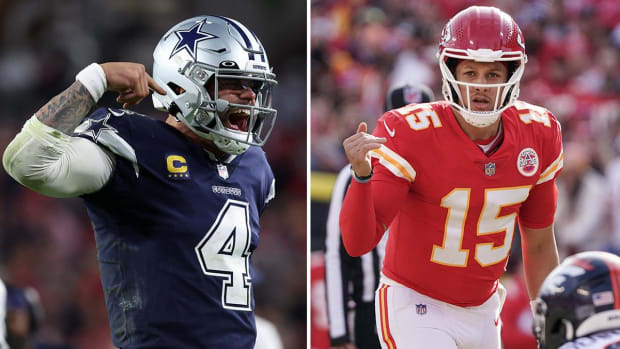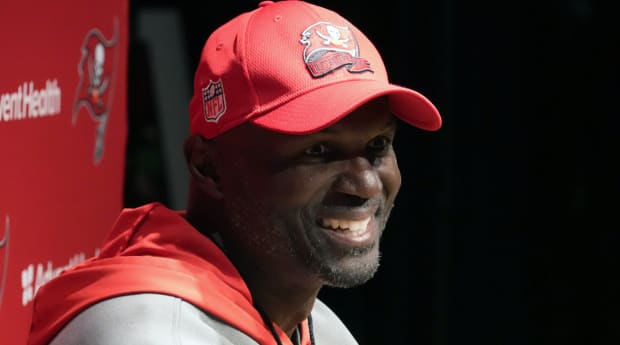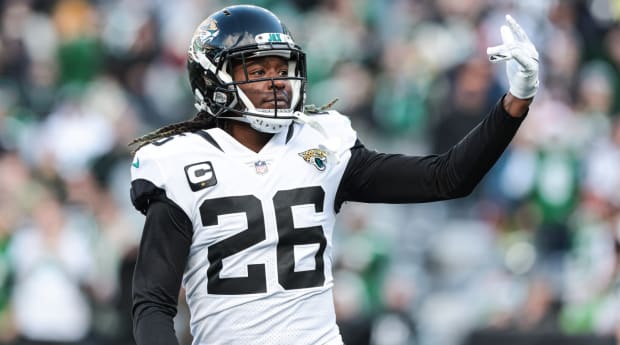More from Albert Breer: Dan Campbell Shares How the Lions Feel About Playing the Chiefs in Week 1 | Why Andrew Whitworth Said Yes to Micah Parsons’s ‘Genius Idea’ | Commanders Sale Could Impact Future NFL Team Purchases
Next week, the spring league meeting and OTAs kick off. Until then, we have some takeaways after last week’s NFL schedule release …
The NFL people I talked to last week uniformly said the biggest change this year in the scheduling challenge was working off the blank slate that dropping conference network affiliations created. That said, those worried that they’ll be nostalgic for the NFC on Fox or the AFC on CBS in the coming years don’t have much to get worked up over.
While those networks don’t have ownership of those games anymore—creating a situation where the broadcast partners were competing for marquee games, rather than taking them away from one another—there are still minimums in place, so there’s a baseline of AFC games on CBS and NFC games on Fox. Also, the broadcast setup is still largely the same, and, when it came time to horse trade, it was obvious to everyone how CBS and Fox leaned.
“It’s really important for Fox and CBS, they are committed—We are the network of the NFC at Fox, and We’re the network of the AFC at CBS,” says NFL VP of broadcasting Onnie Bose. “And so those minimum number of games retain that identity. The plurality of Chiefs and Bills and Bengals games will appear on CBS. And the plurality of Cowboys and Bears and Rams games will appear on Fox. So that’s the building block of it. And, really, we talked about it earlier, the nature of the politicking changed for the top-end games; it’s not taking it away or keeping it. We were going to distribute those as equitably as possible.
“And then on Sunday afternoon, where most of our games are played, and most of our games are consumed by fans, it gave us the flexibility where, once you meet the minimum, once the computer knows it’s got the minimums for every team that it’s obligated to provide, it’s able to build out a Sunday afternoon on CBS or Fox making sure that we have strong windows. We always want to have interesting games and a mix of geography across Sunday at 1 and Sunday at 4:25.”

Kim Klement/USA TODAY Sports and Denny Medley/USA TODAY Sports
The NFL’s been coy about the minimums. But I can tell you that the minimums are set on a per-team basis—CBS is guaranteed a certain amount of games with each AFC team, and Fox is guaranteed a certain amount of games with each NFC team. And if you want to read the tea leaves here, the Chiefs and Cowboys would be on their own tier as far as desirability to the networks goes, and Kansas City has eight games on CBS, and Dallas has eight games on Fox.
While we’re there, the schedule release is also almost always a good indicator of the Q rating of every team. From that perspective, Bose and NFL VP of broadcast planning Mike North were very open with me last week in saying that, again, the Cowboys and Chiefs are in their own tier in that department. And that much is obvious in some of the between-the-lines messaging that came with the schedule release.
• NFL teams can be scheduled for a max of six prime-time games in May, with the league retaining the ability to push that number to seven if it so desires through flex scheduling later in the year. Dallas and Kansas City were, indeed, among the four teams that maxed out with six prime-time games. Buffalo and the Chargers were the other two, and it’s not a coincidence that it took being part of the Peacock exclusive game, to be streamed on Saturday night of Christmas weekend, for those two to get there.
• You may think that pins the league in a bit on the Cowboys and Chiefs. But the NFL already has those two in so many prime-time, stand-alone and 4:25 (rather than 4:05) p.m. ET windows, that it’s unlikely they’d have to flex one of those two. And even if the league tried, it’s a good bet Fox and CBS would protect those games from being flexed.
• That brings us to the other way you can see how sought after a team’s games are—who has the fewest games that aren’t in a prime-time, stand-alone or the 4:25 p.m. ET window. Dallas has two the entire year (Week 8 vs. the Rams, Week 11 at Carolina). The Chiefs have only one (Week 2 at Jacksonville). Philly is another team with a low number, coming in with just four. And Buffalo has only five, with, interestingly enough, old ratings darling New England accounting for two of those five.
• My sense, talking to those guys, was the Monday Night Football window for Aaron Rodgers’s debut as a Jet, at home against Buffalo, was appealing in large part because of the engine that ESPN has to keep the conversation on the game, and Rodgers, going all day long coming out of the first Sunday of games. Five of the Jets’ first 11 games will be stand-alone, national broadcasts, which will satiate the public’s desire to see where that story goes. The Jets then start December with four consecutive 1 p.m. kickoffs, meaning, if they’re as good as some expect, they’ll be a prime flex candidate.
• I figured the league would want to hold back the Bengals and Bills games, and not schedule what could be pivotal AFC showdowns in the kickoff slot, and the league went further than just that—positioning all three games between the conference’s top contenders on the back end of the schedule. The Bengals and Bills face off Nov. 5 on Sunday Night Football, while the Chiefs get both in December (Buffalo on the 10th, and Cincinnati on New Year’s Eve).
And, as is always the case, a bunch of things will probably look differently in November than they do now, so we’ll see how much of this applies. That is, other than the Cowboys drawing ratings—I’m convinced at this point they could put their practice squad out there, and, as long as they were in those uniforms, it’d draw a number.
The price the Browns just paid to get Za’Darius Smith is a good indication of the buyer-beware nature of the trade. In case you missed them, here are the terms: The Browns are sending fifth-round picks in 2024 and ’25 to Minnesota for Smith, and sixth- and seventh-round picks in ’25. So, in other words, all Cleveland had to do was move one pick back a year and down a round, and another down two rounds to land the pass rusher.
That, of course, seems like a paltry sum for a player who has posted double-digit sacks in all three seasons that he’s been a healthy, full-time starter, and should still have some juice left at 30 years old.
The problem is he wore out his welcome in Green Bay and, soon after signing a three-year, $42 million deal with the Vikings in March 2022, did the same in Minnesota, despite having an in-house advocate in Mike Pettine (who was Smith’s defensive coordinator for two years in Green Bay). And to some degree, it was the same deal with the Ravens, who had him from ’15 to ’18, and thought they had an agreement to bring him back before he backed out on a deal with them to go to Minnesota—this time around, it was clear Baltimore wasn’t going back down that road.
And on top of that, the Vikings’ approach with Smith vs. Dalvin Cook was probably as good an example as any here. Cook won’t play for Minnesota at his current number ($11 million) this year. The Vikings have come close to trading him, going deep into talks with Miami a couple of months back. But all along, the communication has been good, and the team has been open to bringing him back on a reduced number. It wasn’t like that with Smith.
So the Browns are taking a swing here. It’s a worthy one, I think, but a swing nonetheless.

Kirby Lee-USA TODAY Sports
Love all the graduation news we got over the past week or so on prominent NFL figures, guys who didn’t necessarily need to get their degree. And we’ll start this short roundup with a 59-year-old head coach, who wound up not just going to his commencement ceremony, but speaking at it.
• That coach is the Buccaneers’ Todd Bowles. He explained over text the simple, powerful motivation behind his work in chipping away at it with online classes over the past few years: “It was a promise I made to my mother when she passed in 2009. That’s the only thing she wanted.” Bowles missed Tampa Bay’s rookie minicamp practice Saturday to be at Mount St. Mary’s graduation, where he told his classmates his mom’s story, and that, in his view, you’re never too old to stop learning, and that “you get old when you stop learning.”
• Eagles QB Jalen Hurts earned a master’s degree in human relations from Oklahoma, and walked with his class Friday. Hurts already had a bachelor’s degree from Alabama, which he earned while playing three seasons for the Crimson Tide, before he went, as a graduate transfer, to OU before the 2019 season (he became a Heisman finalist for the Sooners in his last season of eligibility). Hurts has said his mother’s decision to get her master’s at a time when her colleagues were being laid off motivated him to stick with his education, even when most people wouldn’t have.
• Bears QB Justin Fields graduated from Ohio State with a degree in consumer and family financial services. Fields enrolled at Georgia in January 2018 and transferred to Ohio State a year later. He spent two years at Ohio State, and led the Buckeyes to consecutive Big Ten titles and playoff appearances before declaring for the draft in January ’21—and after his final year at the school was sent sideways during the pandemic.
This, of course, is by no means a complete list. But congrats to those three, and others in pro football who had their graduations over the past couple of weeks, or have one coming up.
I like Jahmyr Gibbs’s response to the idea the Lions reached on him over the weekend. It was simple and to the point: “Everyone is entitled to their opinion. I really don’t care,” he said at the team’s rookie minicamp.
That also reflects how the Lions feel about it.
A couple of days after the draft, we detailed how Detroit saw it—their initial plan was to take Devon Witherspoon with the sixth pick and then, they hoped, trade up from 18 to try to get Gibbs earlier in the teens. Instead, Seattle plucked Witherspoon at No. 5, the Lions pivoted and got Gibbs in a trade down from No. 6 that landed them the 34th pick. GM Brad Holmes then took Iowa LB Jack Campbell at No. 18 and TE Sam LaPorta at No. 34 so, in their mind, instead of Witherspoon and Gibbs, and losing a pick in a deal up, they got three players instead.
Well, we’ve got another piece of context for you, as an addendum to our lead on the Lions landing in the NFL opener. It turns out Detroit had only 14 players with first-round grades in the entire draft class. Gibbs, Campbell and LaPorta were three of them. A fourth was Alabama DB Brian Branch, and the Lions used a fifth-round pick to move up from 48 to 45 to get him.
So, yeah, the Lions don’t really care what people think about their draft. Because as they saw it, they wound up with four of the top 14 players in the whole class.
(That’s also reflective of how opinions on players varied wildly after the first seven or eight guys, with very little consensus on other guys in the class as first-rounders.)
The Rams’ roster composition is very, very interesting, and illustrated how big a reset this year really is for the franchise. As of right now, Los Angeles has 76 players under contract. Twenty-five of those 76 are rookies, and that number doesn’t include the 14 draft picks that haven’t been signed yet. That means, if the team were to bring those 90 to camp, a staggering 39 of them would be rookies.
How does that happen?
Well, as we detailed earlier in the offseason, the Rams have made a very conscious decision to use this year to clean up their salary cap—with the feeling being that kicking the can down the road again this year would essentially turn any such play to clear the decks financially a multiyear process. So they’re carrying around $75 million in dead money, which is a third of the cap for 2023. Again, a third of the cap is accounted for by players who are no longer on the team. Which, obviously, won’t help them win games this year.
As such, there are just six players (Matthew Stafford, Aaron Donald, Cooper Kupp, Joe Noteboom, Rob Havenstein and Tyler Higbee) who are taking home more than $3 million in cash this year, and only nine at $2 million or more. That means, on the back end, a lot of rookies, a lot of guys making the minimum (or not much more) and a very fragile situation that could get pretty problematic with a couple of injuries in the wrong spot.
The good news, of course, is what’s ahead. With the Rams eating all the cap charges this year, and staying away from post–June 1 designations on cuts that would push that money forward, they’ll come off this with $70 million in cap space and a full complement of draft picks for the first time since before Sean McVay was the coach.
And the other thing to provide optimism is the presence of McVay himself—it’s hard to envision where, as long as he’s around, the Rams would have a noncompetitive team, and Donald’s decision to come back is indicative of that.

Vincent Carchietta/USA TODAY Sports
Shaquill Griffin’s case is an under-the-radar example to players—get your money while you can. Two years ago, the corner was set to hit free agency after four years as a starter in Seattle, and get life-changing money. Because of what COVID-19 did to the cap and free agency in 2021, he did have to wait a bit, but eventually his windfall came, with Griffin signing a deal reported at $45 million over three years.
Since then, Griffin had the weird year under Urban Meyer, an injury-marred season under Doug Pederson and then was deemed too costly to get a third year with the team. So the Jaguars cut him in March. That $45 million? He made just over $26 million of it, and sat on the market for two months after his release before finding his next home.
That home wound up being with the Texans on a one-year deal, and their scheme has similarities to the one Griffin was part of in Seattle.
So at 27 years old, Griffin’s prime-earning years may be behind him. Which is why it’s a good thing he took money from the high bidder when he did two years ago, and why every player should heed the warnings such as cases like his provide.
And, finally, the best story of the week—Foster Moreau signing with the Saints. In New Orleans, the free-agent tight end will be reunited with his quarterback from Las Vegas, Derek Carr, and have a chance to build on the really solid 2022 he had with the Raiders.
But, obviously, this story is great for reasons other than those. Moreau was diagnosed with Hodgkin’s lymphoma in March, and planned to take some time off to go through treatment and rehab. So that he could be on the field as soon as later this month, at least on the surface, seems borderline miraculous.
“I think we knew that he was going to be cleared to participate, and we felt like we were a destination that he was certainly interested in. But it’s never done until it’s done,” Saints coach Dennis Allen told reporters. “And so as soon as the draft was over, we had some communication. I will say that we knew where we were looking, and it was just a matter of trying to get something done.”
Pretty incredible story, and one that we’ll all be watching in the months to come.







